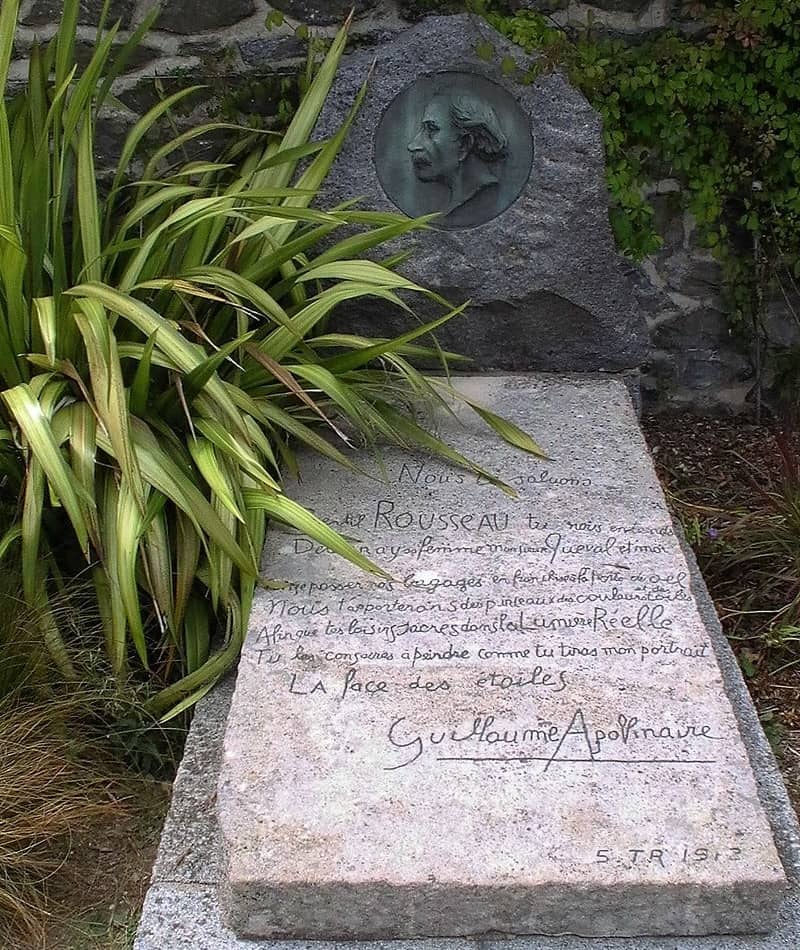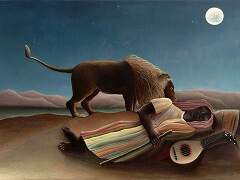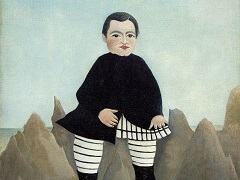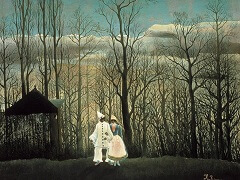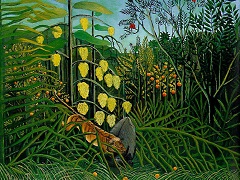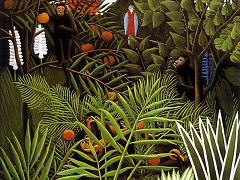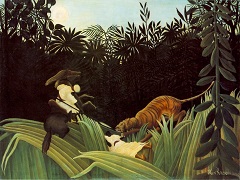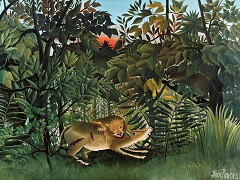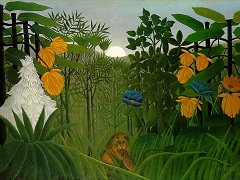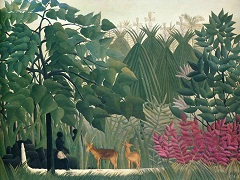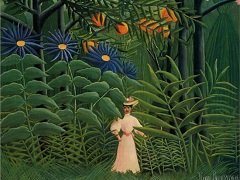Henri Rousseau Biography
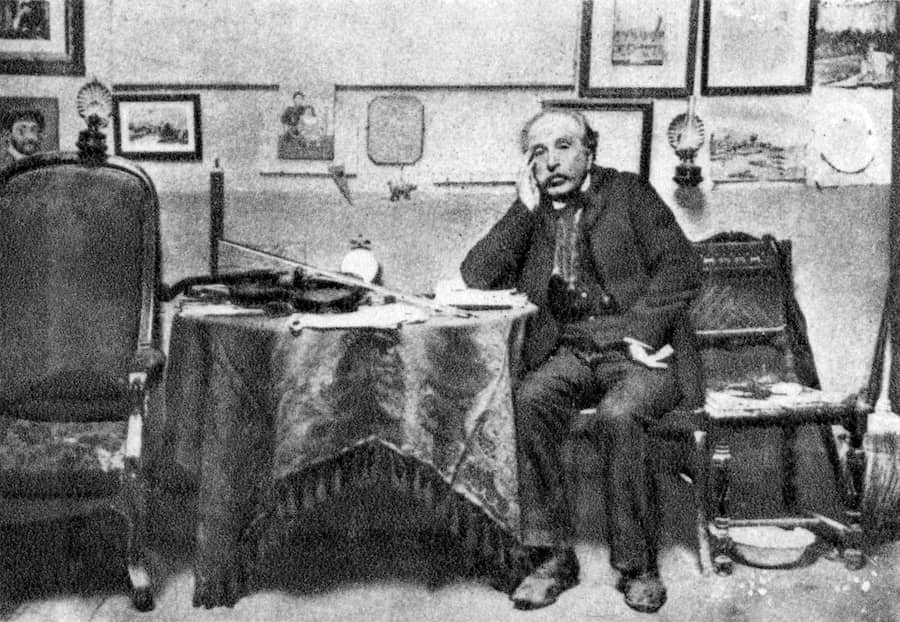
Henri Rousseau (May 21, 1844 - September 2, 1910) was born in Laval, France in the Loire Valley into the family of a tinsmith.He attended Laval High School as a day student and then as a boarder, after his father became a debtor and his parents had to leave the town upon the seizure of their house. He was mediocre in some subjects at the high school but won prizes for drawing and music. He worked for a lawyer and studied law, but "attempted a small perjury and sought refuge in the army," serving for four years, starting in 1863. With his father's death, Rousseau moved to Paris in 1868 to support his widowed mother as a government employee. In 1868 he married Clémence Boitard, his landlord's 15 year-old daughter, with whom he had six children (only one survived). In 1871, he was appointed as a collector of the octroi tax on goods entering Paris. His wife died in 1888 and he married Josephine Noury in 1898. He started painting seriously in his early forties, and by age 49 he retired from his job to work on his art full time.
Rousseau claimed he had "no teacher other than nature", although he admitted he had received "some advice" from two established Academic painters, Felix Auguste-Clement and Jean-Leon Gerome. Essentially he was self-taught and is considered to be a naïve or primitive painter.
His best known paintings depict jungle scenes, even though he never left France or saw a jungle. Stories spread by admirers that his army service included the French expeditionary force to Mexico are unfounded. His inspiration came from illustrated books and the botanical gardens in Paris, as well as tableaux of taxidermied wild animals. He had also met soldiers, during his term of service, who had survived the French expedition to Mexico and listened to their stories of the subtropical country they had encountered. To the critic Arsene Alexandre, he described his frequent visits to the Jardin des Plantes: "When I go into the glass houses and I see the strange plants of exotic lands, it seems to me that I enter into a dream."
Along with his exotic scenes there was a concurrent output of smaller topographical images of the city and its suburbs.
He claimed to have invented a new genre of portrait landscape, which he achieved by starting a painting with a view such as a favourite part of the city, and then depicting a person in the foreground.
At his times he was belittled and even today some art critics regard his art as something nice to look at but not as serious art. Rousseau's flat, seemingly childish style gave him many critics; people often were shocked by his work or ridiculed it. His ingenuousness was extreme, and he was unaware that establishment artists considered him untutored.He always aspired, in vain, to conventional acceptance.Many observers commented that he painted like a child, but the work shows sophistication with his particular technique.
The relationship between Henri Rousseau and his contemporaries or immediate predecessors does not boil down to borrowings that one can interpret as collages pulled together with Rousseau's own language. In the closing years of the nineteenth century, the art of painting was renewed perhaps more profoundly than at any moment in the previous four centuries. Rousseau's oeuvre was by no means isolated, untimely, or fixated on academic or backward models. In the course of time, Henri Rousseau became aware of a painting of rupture, launched by Edouard Manet and the Impressionists. This transformation was elaborated through the years, and Henri Rousseau took a greater part in it than he is generally credited with.
In many paintings, particularly in the tropical landscapes, Henri Rousseau coped with a problem very much on the mid of most artists toward the end of the nineteenth century: the challenge to traditional perspective. Need we recall how profoundly the Impressionists, and then Paul Cezanne, Claude Monet, Gauguin, Marc Chagall, Van Gogh and countless other, challenged the received ideas of depth and relief, or, rather, challenged the traditional pictorial methods for depicting depth and relief? On this point, Henri Rousseau was no more awkward, no more backward, than his contemporaries in seeking new means of spatial representation.
From 1886 he exhibited regularly in the Salon des Independants, and, although his work was not placed prominently, it drew an increasing following over the years. Tiger in a Tropical Storm (Surprised!) was exhibited in 1891, and Rousseau received his first serious review, when the young artist Félix Vallotton wrote: "His tiger surprising its prey ought not to be missed; it's the alpha and omega of painting." Yet it was more than a decade before Rousseau returned to depicting his vision of jungles.
In 1893, Rousseau moved to a studio in Montparnasse where he lived and worked until his death in 1910. During 1897 he produced one of his most famous paintings, La Bohemienne endormie (The Sleeping Gypsy).
During 1905 a large jungle scene The Hungry Lion Throws Itself on the Antelope was exhibited at the Salon des Indépendants near works by younger leading avant-garde artists such as Henri Matisse in what is now seen as the first showing of The Fauves. Rousseau's painting may even have influenced the naming of the Fauves.
In 1907 he was commissioned by artist Robert Delaunay's mother, Berthe, Comtesse de Delaunay, to paint The Snake Charmer.
When Pablo Picasso happened upon a painting by Rousseau being sold on the street as a canvas to be painted over, the younger artist instantly recognised Rousseau's genius and went to meet him. In 1908 Picasso held a half serious, half burlesque banquet in his studio in Le Bateau-Lavoir in Rousseau's honour.
After Rousseau's retirement in 1893, he supplemented his small pension with part-time jobs and work such as playing a violin in the streets. He also worked briefly at Le petit journal, where he produced a number of its covers.
Rousseau exhibited his final painting, The Dream, at the 1910 Salon des Independants a few months before his death on 2 September 1910 in the Hospital Necker in Paris. At his funeral, seven friends stood at his grave in the Cimetiere de Bagneux: the painters Paul Signac and Manuel Ortiz de Zárate, the artist couple Robert Delaunay and Sonia Terk, the sculptor Brancusi, Rousseau's landlord Armand Queval and Guillaume Apollinaire who wrote the epitaph Brancusi put on the tombstone:
We salute you Gentle Rousseau you can hear us.
Delaunay, his wife, Monsieur Queval and myself.
Let our luggage pass duty free through the gates of heaven.
We will bring you brushes paints and canvas.
That you may spend your sacred leisure in the light and Truth of Painting.
As you once did my portrait facing the stars, lion and the gypsy."
